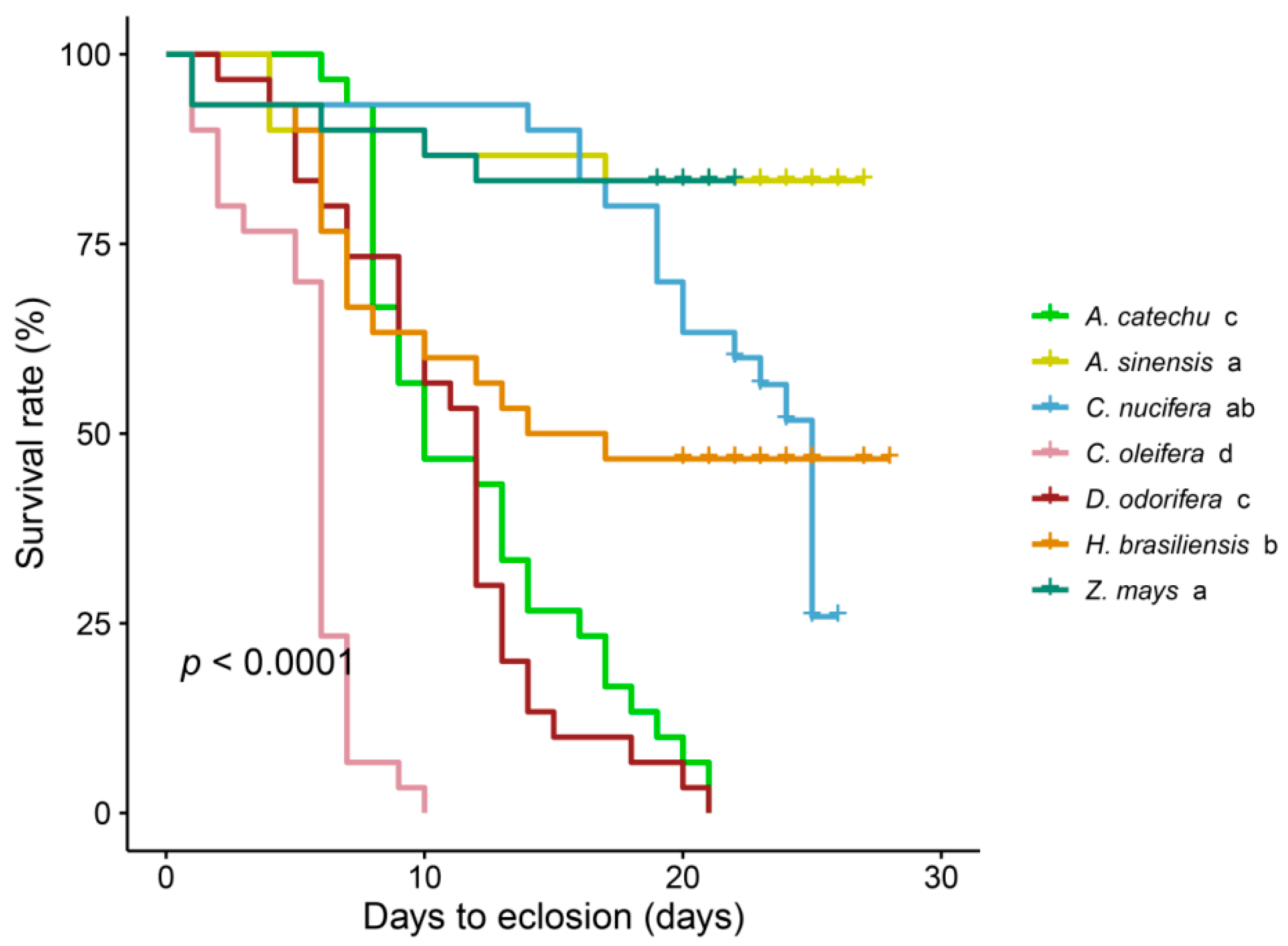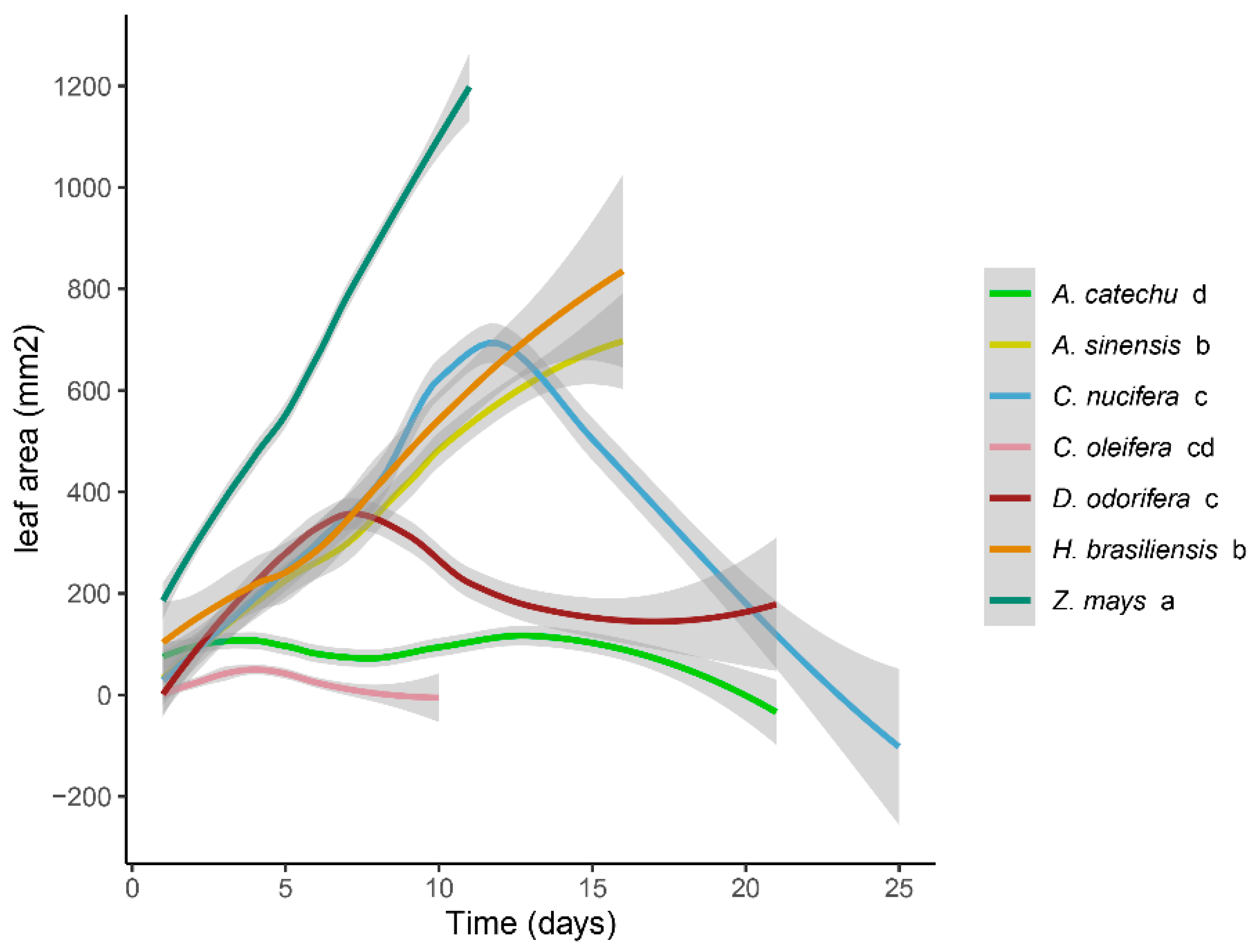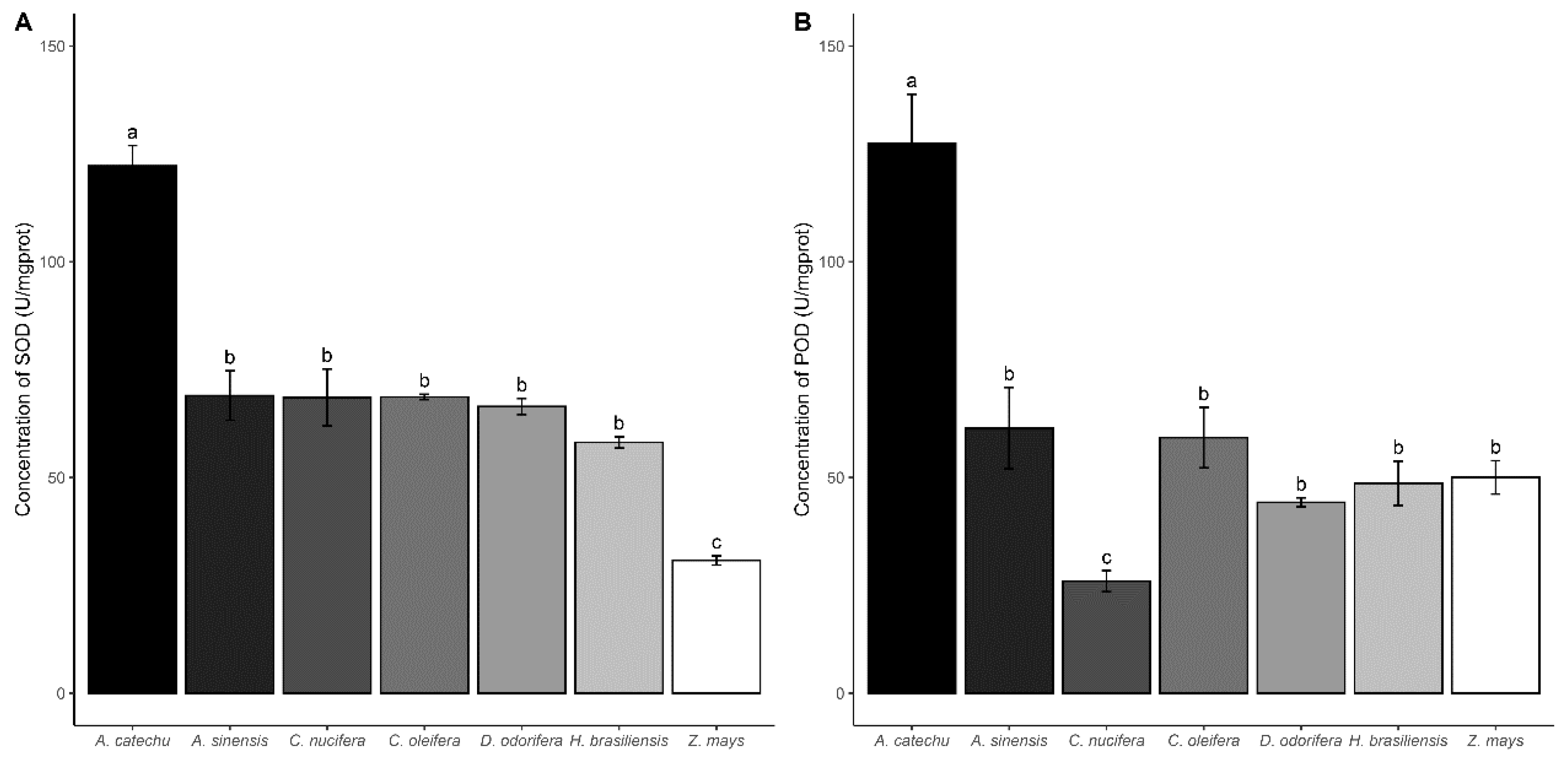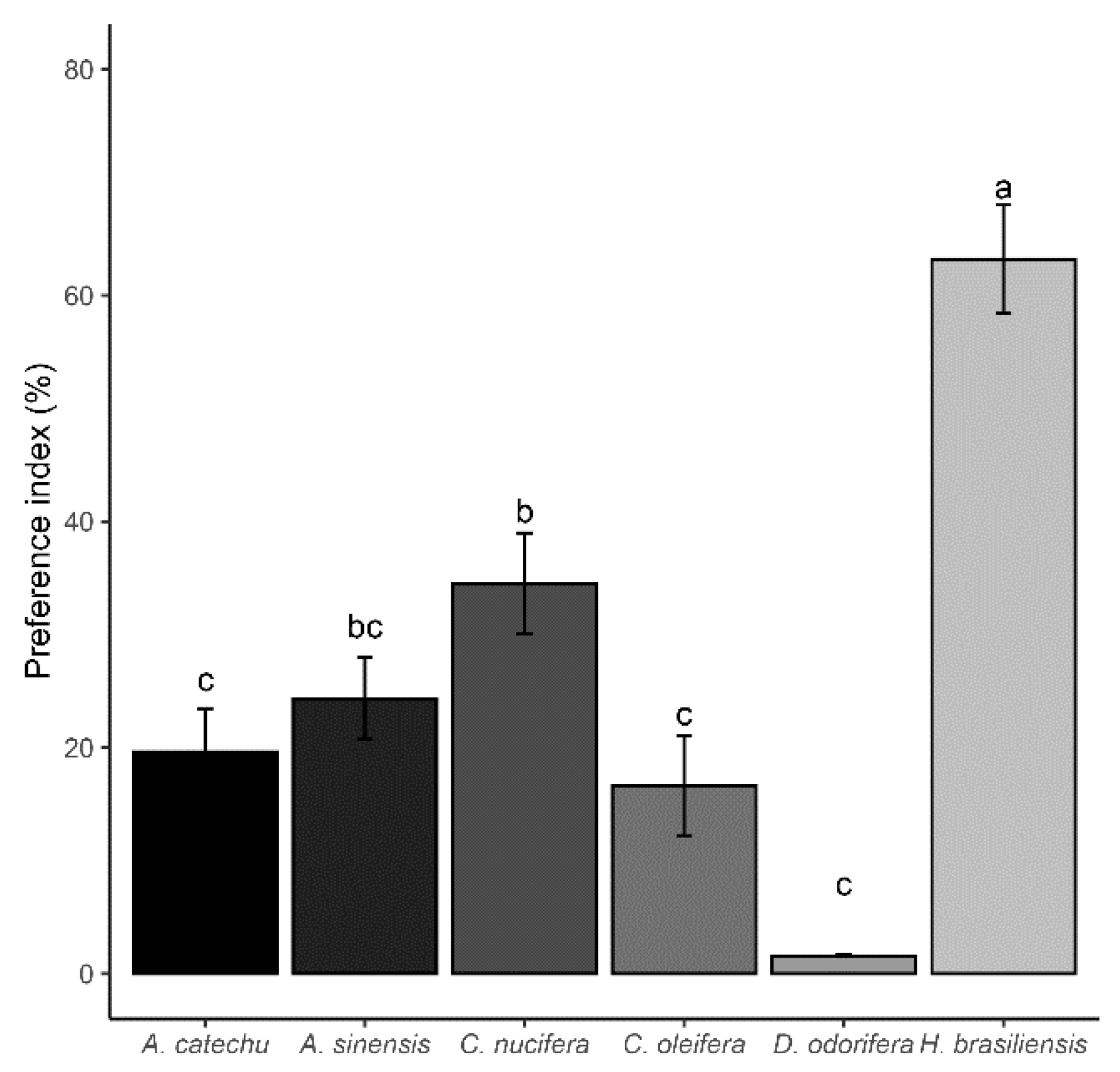Submitted:
01 March 2024
Posted:
04 March 2024
You are already at the latest version
Abstract
Keywords:
1. Introduction
2. Materials and Methods
2.1. Plants and Insects
2.2. Feeding Patterns and Developmental Characteristics of S. frugiperda
2.3. Determination of Enzyme Activity
2.4. S. frugiperda Feeding Preferences
2.5. Data Analysis
3. Results
3.1. Variability in S. frugiperda Survival among Various Plant Species
3.2. Leaves Consumption of S. frugiperda
3.3. Performance of S. frugiperda on Different Diets
3.4. Enzyme Activity
3.5. Feeding Preference Results of S. frugiperda
4. Discussion
5. Conclusions
Supplementary Materials
Funding
Author Contribution
Data Availability
Conflict of Interest
References
- Sparks, A.N. A Review of the Biology of the Fall Armyworm. The Florida Entomologist 1979, 62, 82. [Google Scholar] [CrossRef]
- Shi, W.P. How greedy are the fall armyworm? Journal of Plant Protection 2020, 47, 687–691. [Google Scholar] [CrossRef]
- Kenis, M. Prospects for Classical Biological Control of Spodoptera Frugiperda (Lepidoptera: Noctuidae) in Invaded Areas Using Parasitoids from the Americas. J Econ Entomol 2023, 116, 331–341. [Google Scholar] [CrossRef] [PubMed]
- Sun, X.; Hu, C.; Jia, H.; Wu, Q.; Shen, X.; Zhao, S.; Jiang, Y.; Wu, K. Case Study on the First Immigration of Fall Armyworm, Spodoptera Frugiperda Invading into China. Journal of Integrative Agriculture 2021, 20, 664–672. [Google Scholar] [CrossRef]
- Wu, K.M. Management strategies of fall armyworm (Spodoptera frugiperda) in China. Plant Protection 2020, 46, 1–5. [Google Scholar] [CrossRef]
- Tang, J.; Lu, B.; Lu, H.; Ji, X.; Yang, P.; Su, H.; Cai, B. Investigation and Preliminary Study of Biological Characteristic of Parasitic Wasps of Spodoptera frugiperda in Hainan. Chinese Journal of Tropical Crops 2020, 41, 1189–1195. [Google Scholar] [CrossRef]
- Zhang, L.; Liu, B.; Jiang, Y.Y.; Liu, J.; Wu, K.M.; Xiao, Y.T. Molecular characterization analysis of fall armyworm populations in China. Plant Protection 2019, 45, 20–27. [Google Scholar] [CrossRef]
- Liu, J.; Jiang, Y.Y.; Wu, Q.L.; Zhao, S.Y.; Li, H. Characteristics of noctuid moth infestation in grassland in China in winter and spring, and analysis of the occurrence trend in the second half of the year. China Plant Protection 2019, 39, 36–38+49. [Google Scholar] [CrossRef]
- Jiang, Y.Y.; Liu, J.; Xie, M.C.; Li, Y.H.; Yang, J.J.; Zhang, M.L.; Qiu, K. Observation on law of diffusion damage of Spodoptera frugiperda in China in 2019. Plant Protection 2019, 45, 10–19. [Google Scholar] [CrossRef]
- Fen, R.S. Characteristics of the Occurrence and Control Measures of Spodoptera frugiperda. Seed Science 2023, 41, 116–118. [Google Scholar] [CrossRef]
- Juárez, M.L.; Socías, M.G.; Murúa, M.G.; Prieto, S.; Medina, S.; Willink, E. Revisión de los hospederos del gusano cogollero del maíz, Spodoptera frugiperda (Lepidoptera: Noctuidae). Rev. Soc. Entomol. Arg. 2010, 69, 3–4. [Google Scholar]
- Montezano, D.G.; Specht, A.; Sosa-Gómez, D.R.; Roque-Specht, V.F.; Sousa-Silva, J.C.; Paula-Moraes, S.V.; Peterson, J.A.; Hunt, T.E. Host Plants of Spodoptera Frugiperda (Lepidoptera: Noctuidae) in the Americas. African Entomology 2018, 26, 286–300. [Google Scholar] [CrossRef]
- Sun, R.; Gao, L.; Mi, Z.; Zheng, Y.; Li, D. CnMADS1, a MADS Transcription Factor, Positively Modulates Cell Proliferation and Lipid Metabolism in the Endosperm of Coconut (Cocos Nucifera L.). Planta 2020, 252, 83. [Google Scholar] [CrossRef] [PubMed]
- Li, M. Planting the Six Trees and Finding the Power Points. Hainan Daily 2022, 5, news.hndaily.cn/html/2022–04/27/content_58468_14759402htm. [Google Scholar]
- Wu, C.B.; Ren, C.C.; Zhu, M.J.; Du, R.K.; Yan, C.Z.; Han, S.; Rui, K.; Lu, C.J. Efficacy of a combination of carbofuran and azoxystrobin against red-veined spike borer of betel nut. China Plant Protection 2022, 42, 83–85. [Google Scholar] [CrossRef]
- Meng, X.L.; Song, W.W.; Tang, Q.H.; Niu, X.Q.; Li, C.X.; Zhong, B.Z.; Lv, C.J.; Huang, S.C.; Qin, W.Q. Advances in Main Diseases and Insect Pests of Areca Palm. Chinese Journal of Tropical Crops 2021, 42, 3055–3065. [Google Scholar] [CrossRef]
- Tang, Q.B.; Wang, C.Z. Leaf disctest used in caterpillar feeding preference study. Chinese Bulletin of Entomology 2007, 912–915. [Google Scholar] [CrossRef]
- Yong, Z.; Hao-Ru, T.; Ya, L. Variation in Antioxidant Enzyme Activities of Two Strawberry Cultivars with Short-Term Low Temperature Stress. 2008, 4, 458–462, http://www.idosi.org/wjas/wjas4(4)/8.pdf. [Google Scholar]
- Loh, K.P.; Qi, J.; Tan, B.K.H.; Liu, X.H.; Wei, B.G.; Zhu, Y.Z. Leonurine Protects Middle Cerebral Artery Occluded Rats Through Antioxidant Effect and Regulation of Mitochondrial Function. Stroke 2010, 41, 2661–2668. [Google Scholar] [CrossRef]
- Li, H.-X.; Xiao, Y.; Cao, L.-L.; Yan, X.; Li, C.; Shi, H.-Y.; Wang, J.-W.; Ye, Y.-H. Cerebroside C Increases Tolerance to Chilling Injury and Alters Lipid Composition in Wheat Roots. PLoS One 2013, 8, e73380. [Google Scholar] [CrossRef]
- Su, X.N.; Li, C.Y.; Xu, Y.J.; Huang, S.H.; Liu, W.L.; Liao, Z.X.; Zhang, Y.P. Feeding preference and adaptability of fall armyworm Spodoptera frugiperda on five species of host plants and six weeds. Journal of Environmental Entomology 2022, 44, 263–272. [Google Scholar] [CrossRef]
- CITES. Convention on International Trade in Endangered Species of Wild Fauna and Flora. Available online: https://www.cites.org/eng/disc/what.php.
- Song, J.; Zhang, L.N.; Zhang, Z.H.; Zhou, Z.Z.; Liang, J.F.; Lu, J.K. High-throughput Sequencing Analysis of Fungal Diversity in Agar-wood Wound Locations. Chinese Journal of Tropical Crops 2020, 46–47. [Google Scholar] [CrossRef]
- Zhou, Y.K.; Qiao, H.L.; Zhan, Q.Q.; Zhao, X.S.; Lu, L.L.; Chen, J. Occurrence and Control of the Disease and Pests Damage on Aquilaria Siensis in Hainan. Modern Chinese Medicine 2017, 19, 1102–1105. [Google Scholar] [CrossRef]
- Silva, D.M.D.; Bueno, A.D.F.; Andrade, K.; Stecca, C.D.S.; Neves, P.M.O.J.; Oliveira, M.C.N.D. Biology and Nutrition of Spodoptera Frugiperda (Lepidoptera: Noctuidae) Fed on Different Food Sources. Scientia Agricola 2017, 74, 18–31. [Google Scholar] [CrossRef]
- Carrasco, D.; Larsson, M.C.; Anderson, P. Insect Host Plant Selection in Complex Environments. Current Opinion in Insect Science 2015, 8, 1–7. [Google Scholar] [CrossRef] [PubMed]
- Lu, W.; Hou, M.L.; Wen, J.H.; Li, J.W. Effects of plant volatiles on herbivorous insects. Plant Protection 2007, 7–11. [Google Scholar] [CrossRef]
- Moreau, J.; Benrey, B.; Thiéry, D. Grape Variety Affects Larval Performance and Also Female Reproductive Performance of the European Grapevine Moth Lobesia Botrana (Lepidoptera: Tortricidae). Bull Entomol Res 2006, 96, 205–212. [Google Scholar] [CrossRef]
- Chen, Y.; Gao, Y.; Zhu, H.; Romeis, J.; Li, Y.; Peng, Y.; Chen, X. Effects of Straw Leachates from Cry1C-Expressing Transgenic Rice on the Development and Reproduction of Daphnia Magna. Ecotoxicology and Environmental Safety 2018, 165, 630–636. [Google Scholar] [CrossRef]
- Kumar, A.; Vajpayee, P.; Ali, M.B.; Tripathi, R.D.; Singh, N.; Rai, U.N.; Singh, S.N. Biochemical Responses of Cassia Siamea Lamk. Grown on Coal Combustion Residue (Fly-Ash). Bulletin of Environmental Contamination and Toxicology 2002, 68, 675–683. [Google Scholar] [CrossRef]
- Marciniak, B.; Grabowicz, W.; Ferenc, T. Evaluation of Micronuclei in Mice Bone Marrow and Antioxidant Systems in Erythrocytes Exposed to A-Amanitin. 2013, 63, 147–153. [Google Scholar] [CrossRef]
- Vuleta, A. Adaptive Flexibility of Enzymatic Antioxidants SOD, APX and CAT to High Light Stress: The Clonal Perennial Monocot Iris Pumila as a Study Case. Plant Physiology and Biochemistry 2016, 100, 166–173. [Google Scholar] [CrossRef] [PubMed]
- Ismaiel, M.M.S.; El-Ayouty, Y.M.; Piercey-Normore, M. Role of pH on Antioxidants Production by Spirulina (Arthrospira) Platensis. Brazilian Journal of Microbiology 2016, 47, 298–304. [Google Scholar] [CrossRef]
- Alyokhin, A.; Benkovskaya, G.; Udalov, M. Chapter 4 - Colorado Potato Beetle. In Insect Pests of Potato (Second Edition); Alyokhin, A., Rondon, S.I., Gao, Y., Eds.; Academic Press, 2022; pp. 29–43. ISBN 978-0-12-821237-0. [Google Scholar] [CrossRef]
- Jernelöv, A. The Colorado (Potato) Beetle. In The Long-Term Fate of Invasive Species: Aliens Forever or Integrated Immigrants with Time? Jernelöv, A., Ed.; Springer International Publishing: Cham, 2017; ISBN 978-3-319-55396-2. [Google Scholar] [CrossRef]
- Chen, Z.M. Chemical Ecology of Tea Tree Pests. Shanghai Scientific & Technical Publishers: Shanghai, 2013. [Google Scholar]
- Lu, Y.; Wu, K.; Jiang, Y.; Xia, B.; Li, P.; Feng, H.; Wyckhuys, K.A.G.; Guo, Y. Mirid Bug Outbreaks in Multiple Crops Correlated with Wide-Scale Adoption of Bt Cotton in China. Science 2010, 328, 1151–1154. [Google Scholar] [CrossRef] [PubMed]
- Rwomushana, I. Spodoptera Frugiperda (Fall Armyworm). CABI Compendium 2019, CABI Compendium, 29810. [Google Scholar] [CrossRef]
- Heppner, J.B. Lepidoptera of Florida, Part 1: Introduction and Catalog. Arthropods of Florida and Neighboring Land Areas 2007, 17, 1–670. [Google Scholar]
- Casmuz, A.; Juárez, M.L.; Socías, M.G.; Murúa, M.G.; Prieto, S.; Medina, S.; Willink, E.; Gastaminza, G. Revisión de Los Hospederos Del Gusano Cogollero Del Maíz, Spodoptera Frugiperda (Lepidoptera: Noctuidae) Review of the Host Plants of Fall Armyworm, Spodoptera Frugiperda (Lepidoptera: Noctuidae). Revista de la Sociedad Entomológica Argentina 2010, 69, 209–231. [Google Scholar]
- Silva, A.G.A.; Goncalves, C.R.; Galvão, D.M.; Gonçalves, A.J.L.; Gomes, J.; Silva, M.N.; Simoni, L.; Silva, R.; Galvao, D.; Gonçalves, M. Quarto Catálogo Dos Insetos Que Vivem Nas Plantas Do Brasil. Seus Parasitos e Predadores: Parte 2, Tomo 1o, Insetos, Hospedeiros e Inimigos Naturais – ScienceOpen. In; Ministério da Agricultura: Rio de Janeiro, Brasil, 1968. [Google Scholar]
- Wang, Z.; Cao, H. The Complete Mitochondrial Genome Sequence of Aquilaria Sinensis. Mitochondrial DNA Part B Resources 2021, 6. [Google Scholar] [CrossRef]
- Cui, C.; Yang, Y.; Zhao, T.; Zou, K.; Peng, C.; Cai, H.; Wan, X.; Hou, R. Insecticidal Activity and Insecticidal Mechanism of Total Saponins from Camellia Oleifera. Molecules 2019, 24, 4518. [Google Scholar] [CrossRef] [PubMed]
- Mohan, C.; Radhakrishnan Nair, C.P.; Nampoothiri, C.K.; Rajan, P. Leaf-Eating Caterpillar (Opisina Arenosella)-Induced Yield Loss in Coconut Palm. Int. J. Trop. Insect Sci. 2010, 30, 132–137. [Google Scholar] [CrossRef]
- Shameer, K.S.; Nasser, M.; Mohan, C.; Hardy, I.C.W. Direct and Indirect Influences of Intercrops on the Coconut Defoliator Opisina Arenosella. J Pest Sci 2018, 91, 259–275. [Google Scholar] [CrossRef]
- Wang, Y.C.; Qin, W.K. Main pests and diseases of coconut in Hainan. Chinese Journal of Tropical Agriculture 2000, 59–62. [Google Scholar] [CrossRef]
- Yan, W.; Lv, B.Q.; Li, H.; Li, C.X.; Liu, L.; Qin, W.Q.; Peng, Z.Q.; Luo, Y.Q. Risk analysis of the coconut blackheaded caterpillar, Opisina arenosella, in China and Hainan Island. Journal of Biosecurity 2013, 22, 163–168. [Google Scholar] [CrossRef]
- Zhang, Y. K.; Zhu, G. Y.; Wang, J. Q.; Wu, Z. H.; A H., C.; Duan, B. Studies on Biological Characteristics of Buzura suppressaria in Rubber Plantation. Tropical Agricultural Science and Technology 2019, 42, 6–9+12. [Google Scholar] [CrossRef]
- Zhu, G.Y.; Zhang, Y.K.; Zhang, Z.B.; Wang, J.Q.; Zhou, M.; Duan, B. Preliminary Study on a New Pest Occurred in Hevea brasiliensis in Xishuangbanna. Tropical Agricultural Science and Technology 2015, 38, 9–11. [Google Scholar] [CrossRef]
- Li, G.Y.; Wang, Q.B.; Li, Y.Y.; Zhou, S.X.; Yv, H.Y. A review of influencing factors on latex yield of Hevea brasiliensis. Chinese Journal of Ecology 2014, 33, 510–517. [Google Scholar] [CrossRef]
- Xiang, T.; Chui, L. X. A Survey of Major Pest Insects and Their Natural Enemies of Dalbergia odorifera Plantations in Hainan. Chinese Journal of Tropical Agriculture 2018, 38, 59–62. [Google Scholar] [CrossRef]
- Zhou, G. Y. Green prevention and control technology of major insect pests of Camellia oleifera (I). Forestry and Ecology 2023, 40–41. [Google Scholar] [CrossRef]
- Zhou, G. Y. Green prevention and control technology of major insect pests of Camellia oleifera (II). Forestry and Ecology 2023, 38–39. [Google Scholar] [CrossRef]




| Parameter | Z. mays | H. brasiliensis | A. sinensis | C. nucifera | D.odorifera | A.catechu | C. oleifer |
|---|---|---|---|---|---|---|---|
| Pupation rate (%) a | 90.00 (30) a | 50.00 (30) b | 86.67 (30) a | 76.67 (30) ab | 0 (30) c | 3.33 (30) c | 0 (30) c |
| Eclosion rate (%) a | 83.33 (30) a | 46.67 (30) b | 83.33 (30) a | 46.67 (30) b | 0 (30) c | 0 (30) c | 0 (30) c |
| Larval development time (d) b | 10.18±0.21 (27) a | 13.27±0.57 (15) b | 14.36±0.32 (26) bc | 16.13±0.55 (23) c | - | 14 (1) | - |
| Pupal development time (d) b | 10.04±0.12 (25) a | 10.79±0.21 (14) b | 10.72±0.13 (25) b | 9.00±0.15 (14) c | - | - | - |
| Pupal length (mm) c | 15.34±0.20 (25) a | 16.11±0.38 (14) a | 15.81±0.23 (25) a | 15.38±0.27 (14) a | - | 12.00 (1) | - |
| Female pupal fresh weight (mg) c | 120.72±2.84 (11) a | 150.00±6.06 (6) b | 130.50±5.08 (6) ab | 111.67±4.00 (12) a | - | - | - |
| Male pupal fresh weight (mg) c | 131.00±3.18 (14) a | 133.00±7.94 (8) a | 143.47±3.00 (19) a | 127.00±3.00 (2) a | - | - | - |
| Pupal mean fresh weight (mg) | 126.48±3.17 (25) a | 140.29±5.56 (14) b | 140.36±3.70 (25) b | 113.86±0.3.73 (14) a | |||
| Females rate (%) a | 44.00 (25) a | 42.86 (14) a | 24.00 (25) a | 85.71 (14) a | - | - | - |
Disclaimer/Publisher’s Note: The statements, opinions and data contained in all publications are solely those of the individual author(s) and contributor(s) and not of MDPI and/or the editor(s). MDPI and/or the editor(s) disclaim responsibility for any injury to people or property resulting from any ideas, methods, instructions or products referred to in the content. |
© 2024 by the authors. Licensee MDPI, Basel, Switzerland. This article is an open access article distributed under the terms and conditions of the Creative Commons Attribution (CC BY) license (http://creativecommons.org/licenses/by/4.0/).





